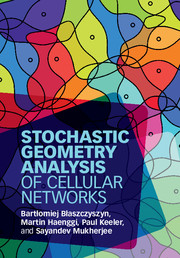Book contents
- Frontmatter
- Contents
- Preface
- Acknowledgments
- Notations
- List of Acronyms and Abbreviations
- Part I Stochastic Geometry
- Part II SINR Analysis
- 5 Downlink SINR: Fundamental Results
- 6 Downlink SINR: Advanced Results
- 7 Downlink SINR: Further Extensions
- 8 Extensions to Non-Poisson Models
- Concluding Remarks
- Appendix A Proof of Lemma 5.3.6
- Appendix B Timeline of Cellular Technology Generations
- Appendix C Some Useful Probability Distributions
- References
- Index
8 - Extensions to Non-Poisson Models
from Part II - SINR Analysis
Published online by Cambridge University Press: 26 March 2018
- Frontmatter
- Contents
- Preface
- Acknowledgments
- Notations
- List of Acronyms and Abbreviations
- Part I Stochastic Geometry
- Part II SINR Analysis
- 5 Downlink SINR: Fundamental Results
- 6 Downlink SINR: Advanced Results
- 7 Downlink SINR: Further Extensions
- 8 Extensions to Non-Poisson Models
- Concluding Remarks
- Appendix A Proof of Lemma 5.3.6
- Appendix B Timeline of Cellular Technology Generations
- Appendix C Some Useful Probability Distributions
- References
- Index
Summary
Non-Poisson Point Processes
Motivation
In Chapters 5–7 we see how Poisson network models often give tractable results, and how random propagation effects such as fading and shadowing can render a network to appear more Poisson. Nevertheless, the Poisson model may still not be appropriate for certain network layouts. For example, although the Poisson process statistically does not exhibit either repulsion or clustering, it is possible for the clusters or voids of points to exist in network layouts.
Appropriate point processes
In Chapter 3 we see just a small selection of the possible spatial point processes. To choose appropriate point processes for network models, researchers have statistically analyzed networks located in various cities to demonstrate that other point processes may be more appropriate, although of course such analyses can be only as good as the data. But when developing stochastic geometry models of cellular networks, the number of suitable and tractable point processes quickly becomes limited. In terms of the SINR for a single user, there are two important and necessary features of a potential point process. One is the knowledge of the Palm distribution, as covered in Section 3.2.4, which immediately limits the choice of possible point processes. The other is being able to write down a calculable expression (at least, numerically) of the Laplace functional of the point process.
In short, although there is a rich range of possible point processes, the bulk of them unfortunately lack the necessary properties that make them tractable in our setting, which partly explains why the clear majority of network models are based on the Poisson point process. Consequently, we restrict ourselves to results for point processes from two general families that exhibit repulsion and clustering, respectively, determinantal processes and a specific shot noise Cox process.
Choice of the base station and propagation effects
In Section 5.1.3, we see the two different model assumptions for how a user at the typical location (the origin) chooses the serving base station under the Poisson model.
Information
- Type
- Chapter
- Information
- Stochastic Geometry Analysis of Cellular Networks , pp. 144 - 167Publisher: Cambridge University PressPrint publication year: 2018
